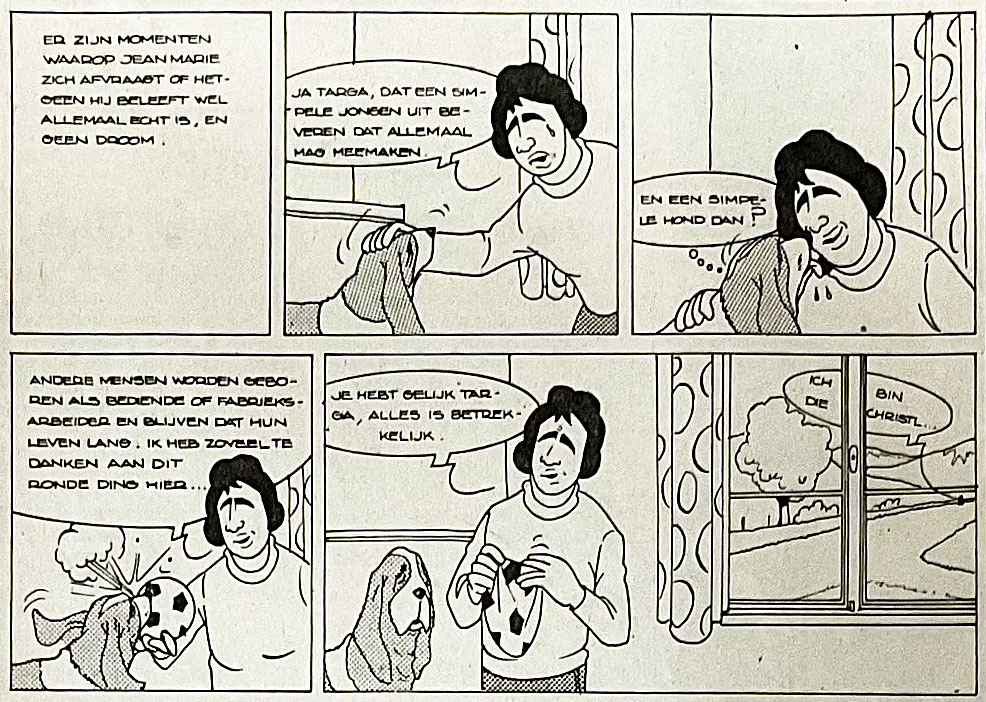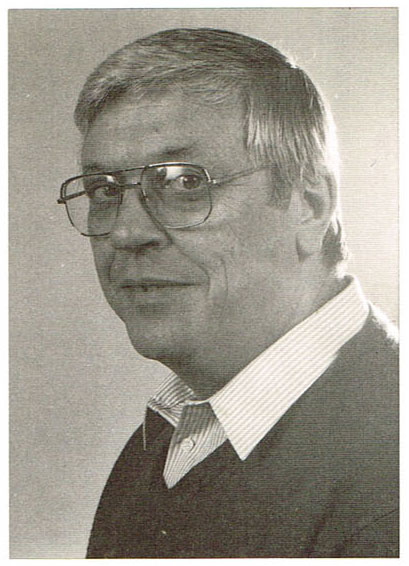'Brabo's Broek', 'Met de Neus op Stap', 1986.
Hugo Leyers was a Flemish architect, political cartoonist and comic artist, who published under the pseudonyms "Hug" and "Haschèl". His career in comics is concentrated in the 1980s, when he made a semi-biographical comic about football goalkeeper Jean-Marie Pfaff (1983) and comic books of the history of Flanders ('De Geschiedenis van Vlaanderen', 1984) and the Netherlands ('De Geschiedenis van Nederland', 1985). The same decade, he also drew a humorous comic strip named 'Met De Neus en Co op Stap' (1986-1987), starring characters from the Antwerp folkloric puppet theater "De Poesje". All of Leyers' comics were published in black-and-white and are notable for their use of caricature, silly comedy, regional atmosphere and Antwerp dialect.
Early life and career
Hugo Leyers was born in 1930 in Ruisbroek, Antwerp. Between 1957 and 1963 and again from 1982 to 1986, Leyers made political cartoons for the Flemish-nationalist right-wing conservative newspaper 't Pallieterke. In 1967, Hugo Leyers was one of the two original teachers at the art academy in Kontich, founded by painter Staf van Elzen. The school still exists today and has expanded considerably since.
'Jean-Marie Pfaff: Op De Keper Beschouwd' (1983).
Jean-Marie Pfaff
From early September through halfway October 1983, newspaper De Gazet van Antwerpen serialized a semi-biographical newspaper comic by Hugo Leyers about the life of association football keeper Jean-Marie Pfaff, 'Jean-Marie Pfaff: Op De Keper Beschouwd'. The cartoonist signed the strip with the pseudonym "Hug". The comic was released when the Belgian national association football team The Red Devils enjoyed a golden era. Under the guidance of trainer Guy Thys, the Red Devils managed to reach the final of the 1980 European Championship Football, but lost to West Germany. During the World Championship Football (1986) in Mexico, the team finished fourth, a record which would stand until 2018, when the Red Devils finished third at the same championship. Pfaff in particular grew out into a national hero. His ability to defend the goal drew respect and admiration. Between 1982 and 1988, he was bought by the German football club Bayern München. Thanks to his curly haircut and happy-go-lucky attitude, Pfaff even became recognizable among people who weren't particularly interested in football. He additionally made people unintentionally laugh with his simple, folksy quotes and a memorable 1982 TV interview during which he tried to speak German, despite not knowing the language.
Surfing on the wave of "Pfaffmania", Hug's 'Jean-Marie Pfaff: Op De Keper Beschouwd' is a loose biographical comic, chronicling Pfaff's life story from birth up until his early 1980s career. The story takes considerable creative liberties: baby Pfaff, for instance, is brought by a stork. Hug's comic holds historical significance as the first attempt to make a comic strip about Pfaff. A year later, in 1984, writer K. Luyckx and artist F. Defossez also made a rudimentary comic about Pfaff, which copied a lot of imagery from Leyers' comic, down to the way Pfaff is graphically designed. The opening scene of Leyers' comic, with baby Pfaff being brought by a stork, is almost literally the same. Two decades later, Ronald Grossey and Charel Cambré created 'De Pfaffs' (2003-2004), a comic series cashing in on the reality series built around Pfaff and his family.
'De Geschiedenis van Nederland', depicting Philippe II of Spain and the Duke of Alba.
De Geschiedenis van Vlaanderen/Nederland
During the 1980s, Leyers became a notable comic artist with additional projects. Again under the pseudonym Hug, he drew two comic stories about the history of the Low Countries. Serialized in the newspaper De Gazet van Antwerpen, 'De Geschiedenis van Vlaanderen' (1984) and 'De Geschiedenis van Nederland' (1985) respectively tell the history of Flanders and The Netherlands in a humorous way. Each title was subsequently released in book format by publishing company Publiboek/Baart in Soest/Deurne. Contrary to what the titles claim, the comics don't offer a complete historical overview. Each volume focuses only a few key historical events, ending the chronological journey in the early 19th century, when The Netherlands and Belgium became independent monarchies in respectively 1815 and 1830. The books conclude with one-page illustrated biographies of famous people from Dutch and Flemish history. At the end of each volume, a possible sequel was hinted at, picking up the history of both countries since their declaration of independence. However, this plan never came to fruition.
In 1985, Leyers made an additional comic strip to commemorate the 400th anniversary of the Fall of Antwerp (1585), when the Habsburg Empire reconquered the Southern Netherlands. This story was only published in de De Gazet van Antwerpen, and not in book form. Interestingly enough, Hug's comic strip about the history of Flanders appeared only five years after Georges Dumont and Louis Haché's overview of Belgian history, 'L'Aventure des Belges/België in Beeld' (1979). Hug's history of the Netherlands happened to coincide with Co Loerakker and Thom Roep's ambitious four-volume comic book version of Dutch history, 'Van Nul tot Nu' (1984-1987). In 2022 and 2023, Standaard Uitgeverij released a new two-volume comic book about the history of Flanders, 'Het Verhaal van Vlaanderen', scripted by Harry De Paepe and drawn by Frodo De Decker.
Met de Neus en Co Op Stap #1 - 'De Putsch Van De Poesje'.
De Neus & Co.
Under the pen name Haschèl, Leyers was the artist of the short-lived comic series 'Met De Neus en Co. op Stap' (1986-1987). It starred the characters from the folkloric Antwerp puppet theater Poesje as main protagonists, namely De Neus ("The Nose"), De Schele ("The Cross-Eyed One"), Nele and De Bult ("The Hunchback"). 'Neus en Co.' is a typical humorous adventure comic with a very regional atmosphere, since most stories take off and end in Antwerp. Mayor of Antwerp Bob Cools, window painter Rubbes and controversial mayor of Voeren/Fourons José Happart have celebrity cameos. Two stories were made, 'De Putsch van de Poesje' (1986) and 'Brabo's Broek' (1987), both serialized in De Gazet van Antwerpen and then released in book format by De Vlijt.
The scriptwriter of the two stories was Pisché, pseudonym for Piet Schepens (31 March 1943 - 28 February 2014). He was a journalist for Gazet van Antwerpen and Kapellmeister (master of the chapel choir) of the Carolus Borromeus Church in Antwerp. Pisché also scripted another obscure comic series, 'De Akkevitjes van Bernaar en Chossé' (1977), drawn by Willy Backer Overbeek, of which two albums, 'De Rubensroof' (1977) and 'De Ellenbooggast' (1981) were published by respectively Oranjehuis en Media Uitgaven.
'De Geschiedenis van Vlaanderen'.
Het Grote Bierbuyck-Boek
In 1988, Hugo Leyers created his final comic book, 'Het Grote Bierbuyck-Boek' (Jempie Herrebout, 1988). Scripted by Hendrik Holvenius (a pseudonym of Herman Geerts), the comic promotes beer culture through the one-shot character Bastiaan Bierbuyck.
Graphic contributions
Leyers illustrated 'Het Grote Krisis-Oplosboek' (Mim/Topics Magazine, 1984), a humorous attempt to solve each national "crisis". The book featured several caricatures of famous Flemish politicians, sports figures and media celebrities. In 1985, Leyers provided cartoons for the book 'Tot De Laatste Snik' (Bertels, 1985), a series of humorous columns reflecting on news events of that year. He also illustrated a book about the celebrated Antwerp puppet tradition, 'Poesje in Antwerpen' (Project, 1988), written by Piet Schepens and Guy Van De Casteele.
Death and family connections
In 2007, Hugo Leyers passed away in Kontich. He was the father of Belgian pop singer and TV host Jan Leyers, best known as one half of the band Soulsister, who had a hit with the song 'The Way To Your Heart' (1987). Hugo Leyers' granddaughters Dorien, Ella, Billie and Olga have also become local media celebrities in Flanders.
Photo of Hugo Leyers, from the back cover of the 'Neus en Co' books.








